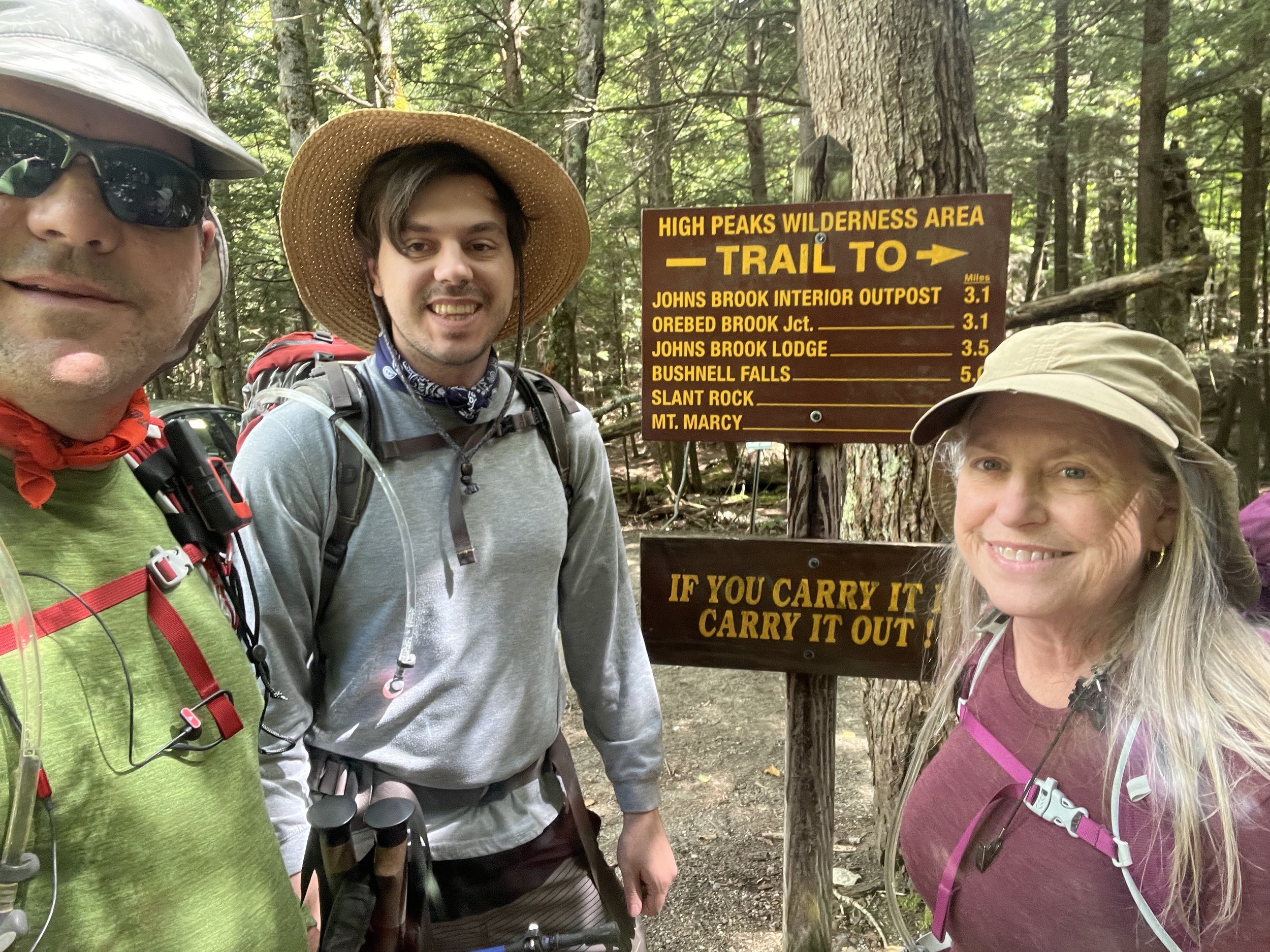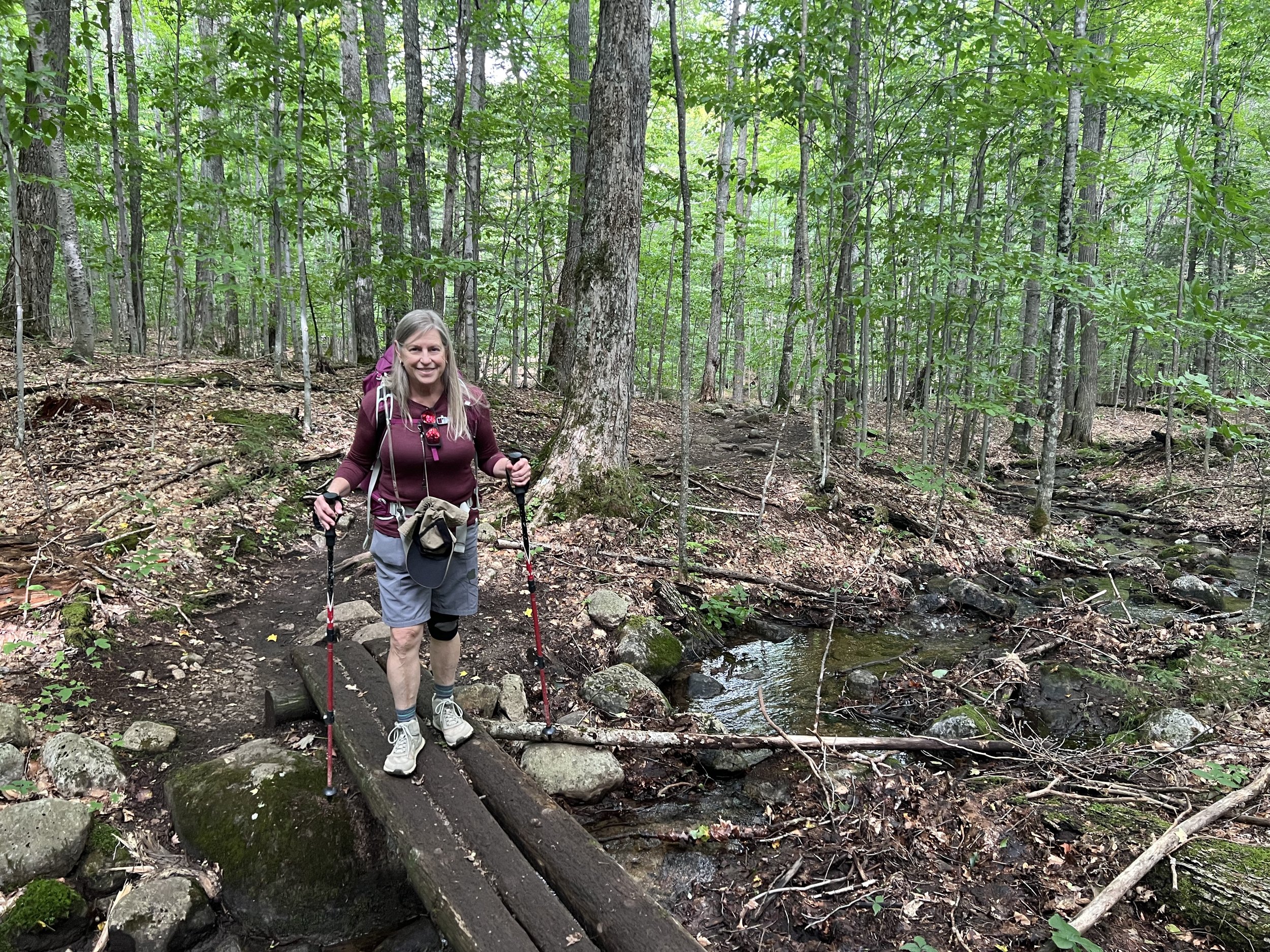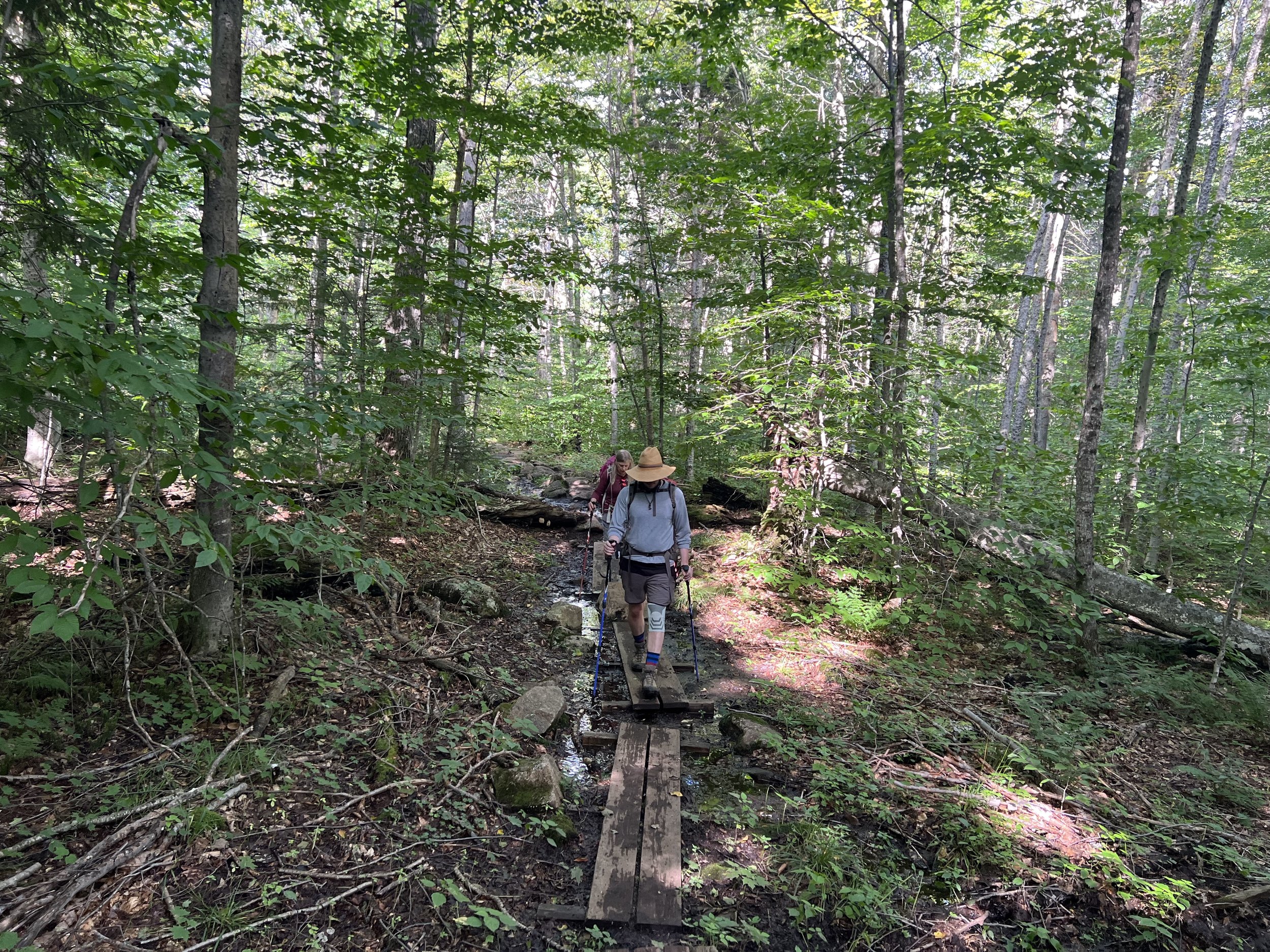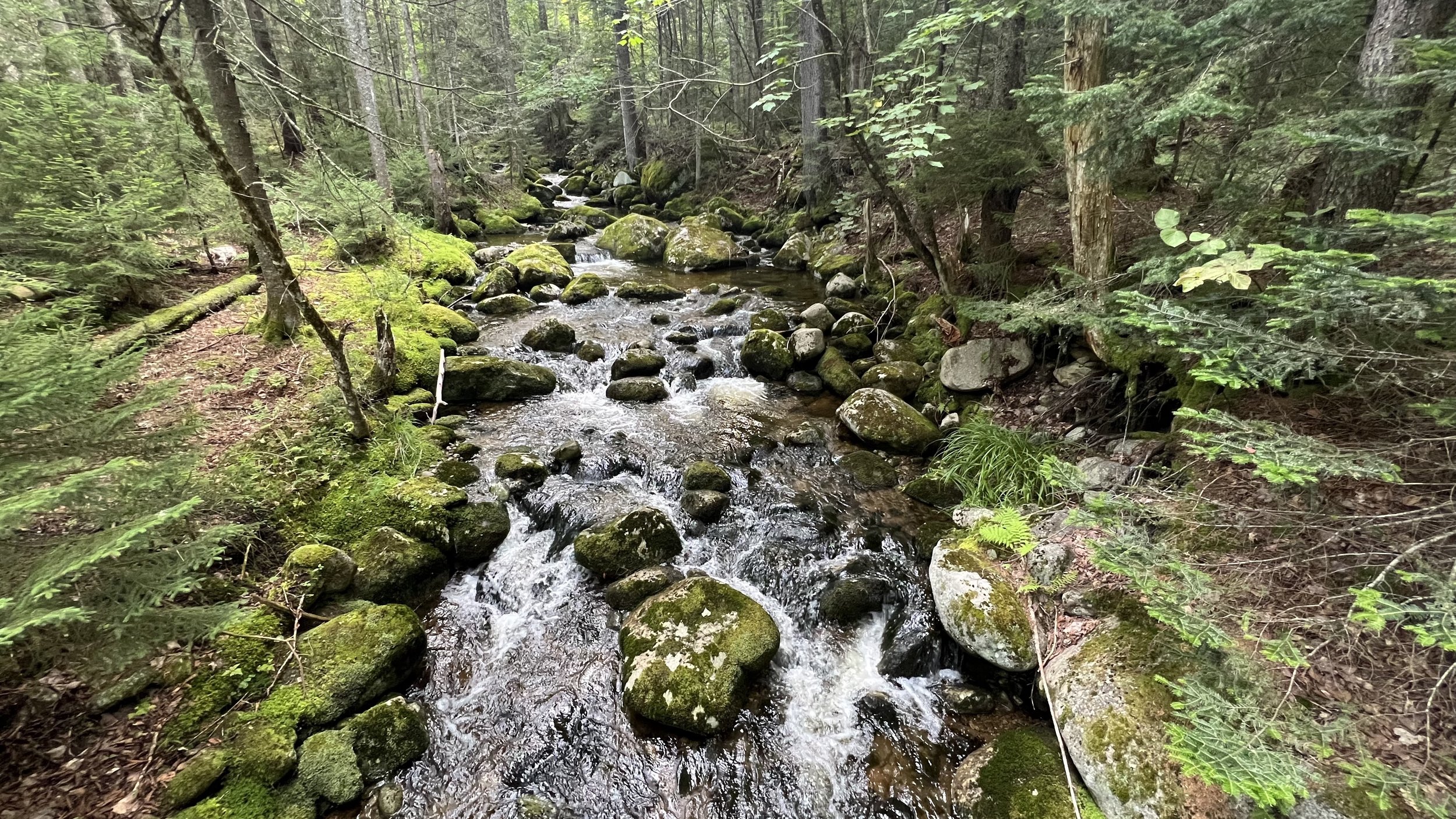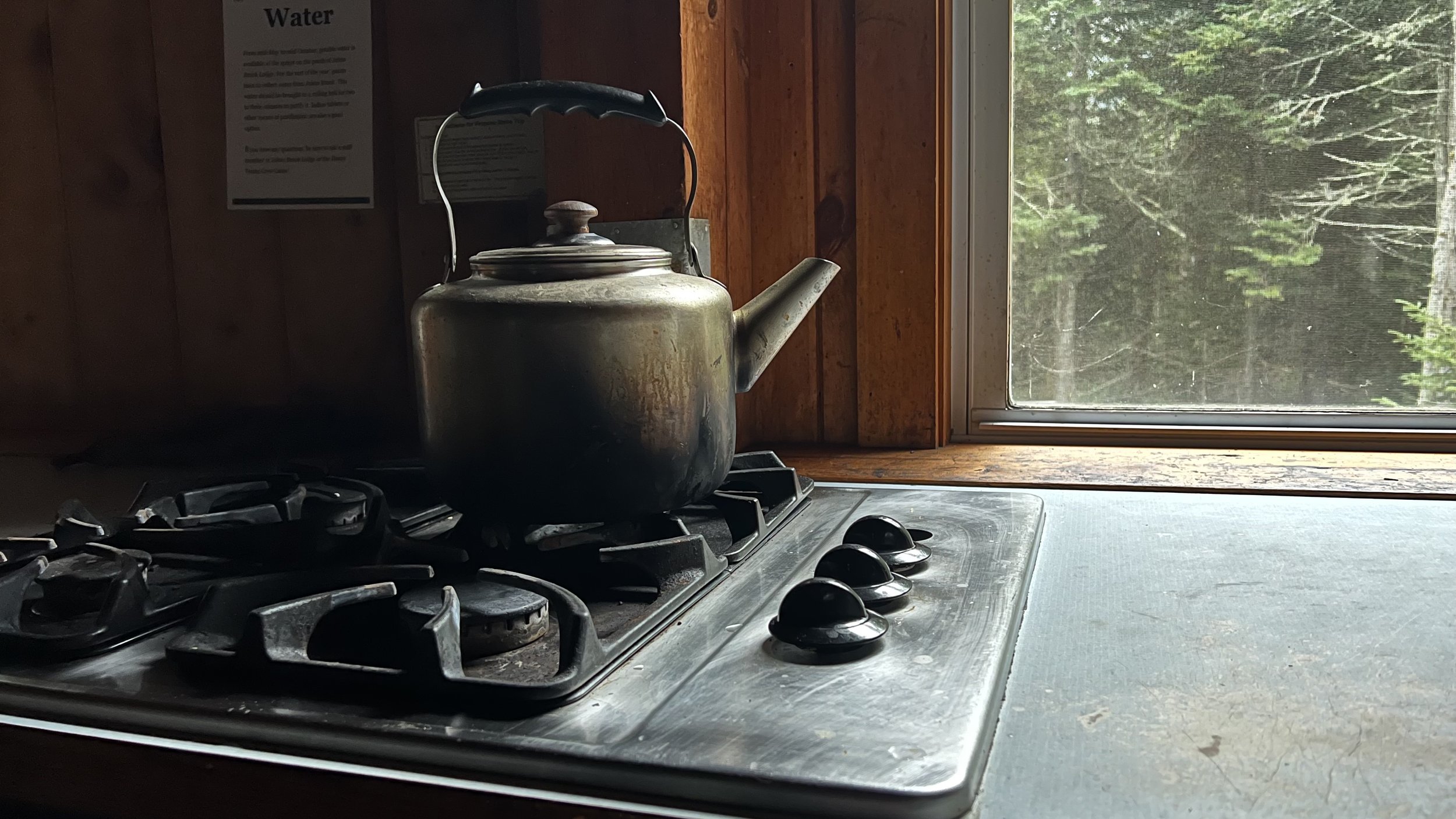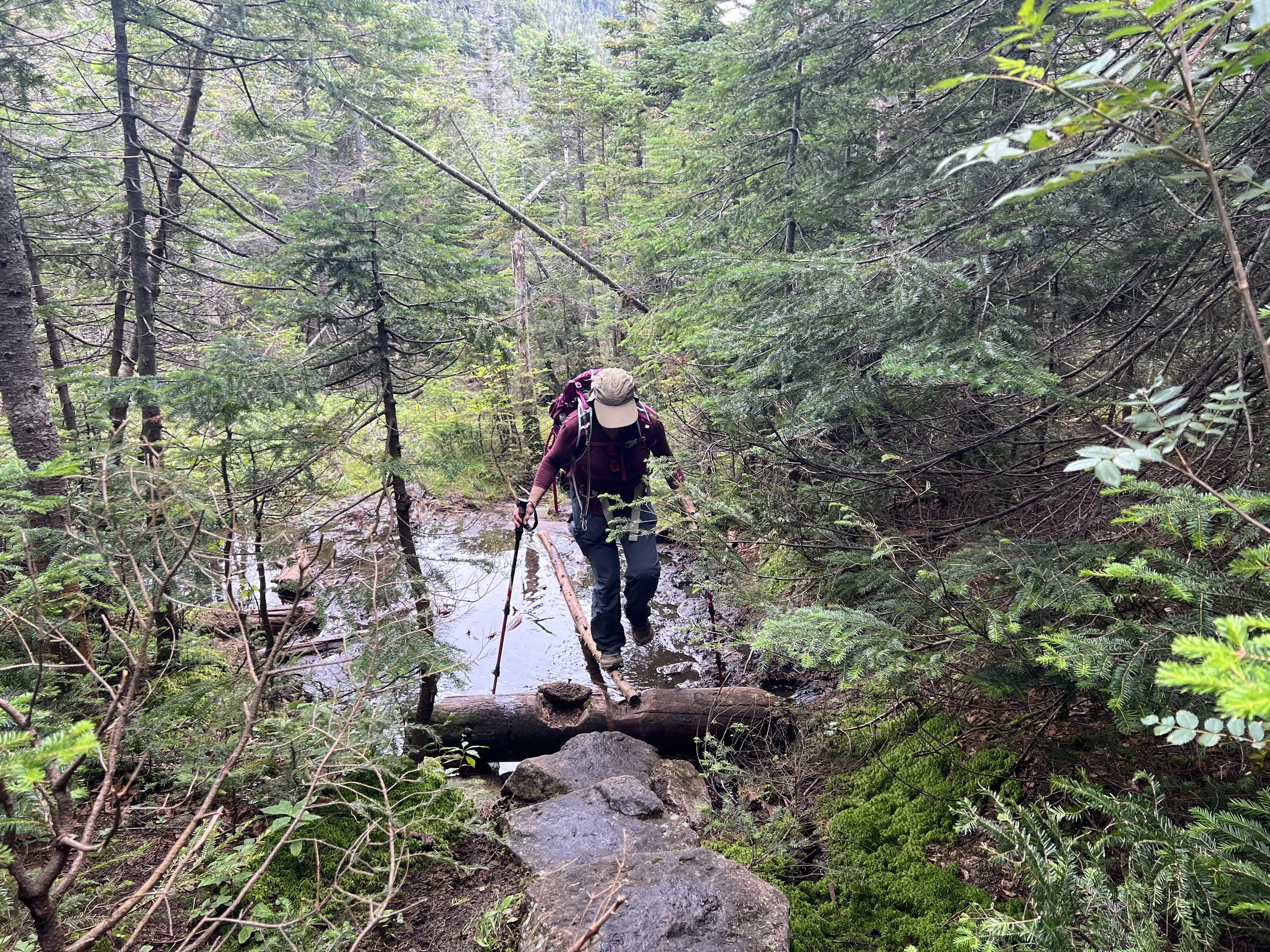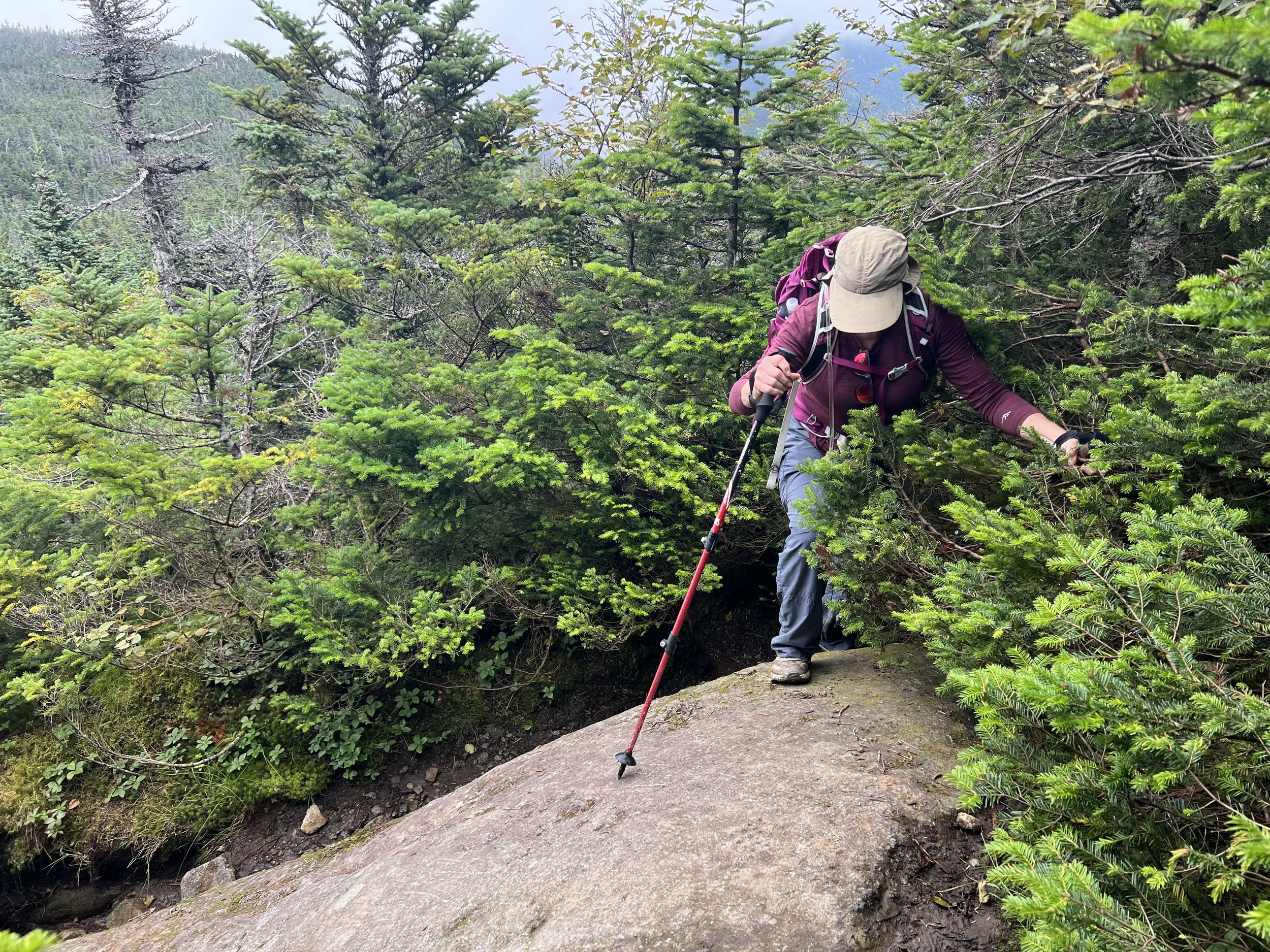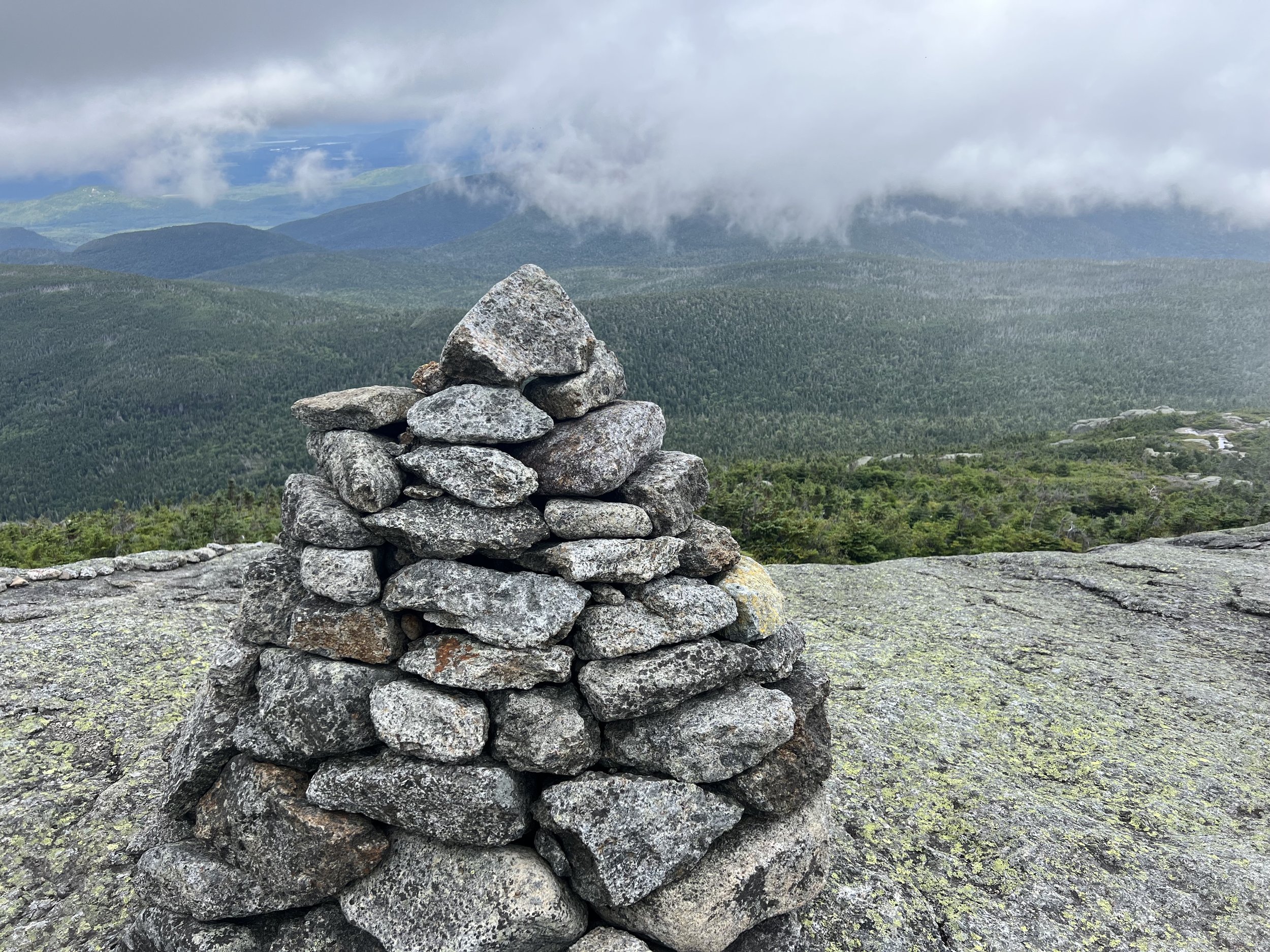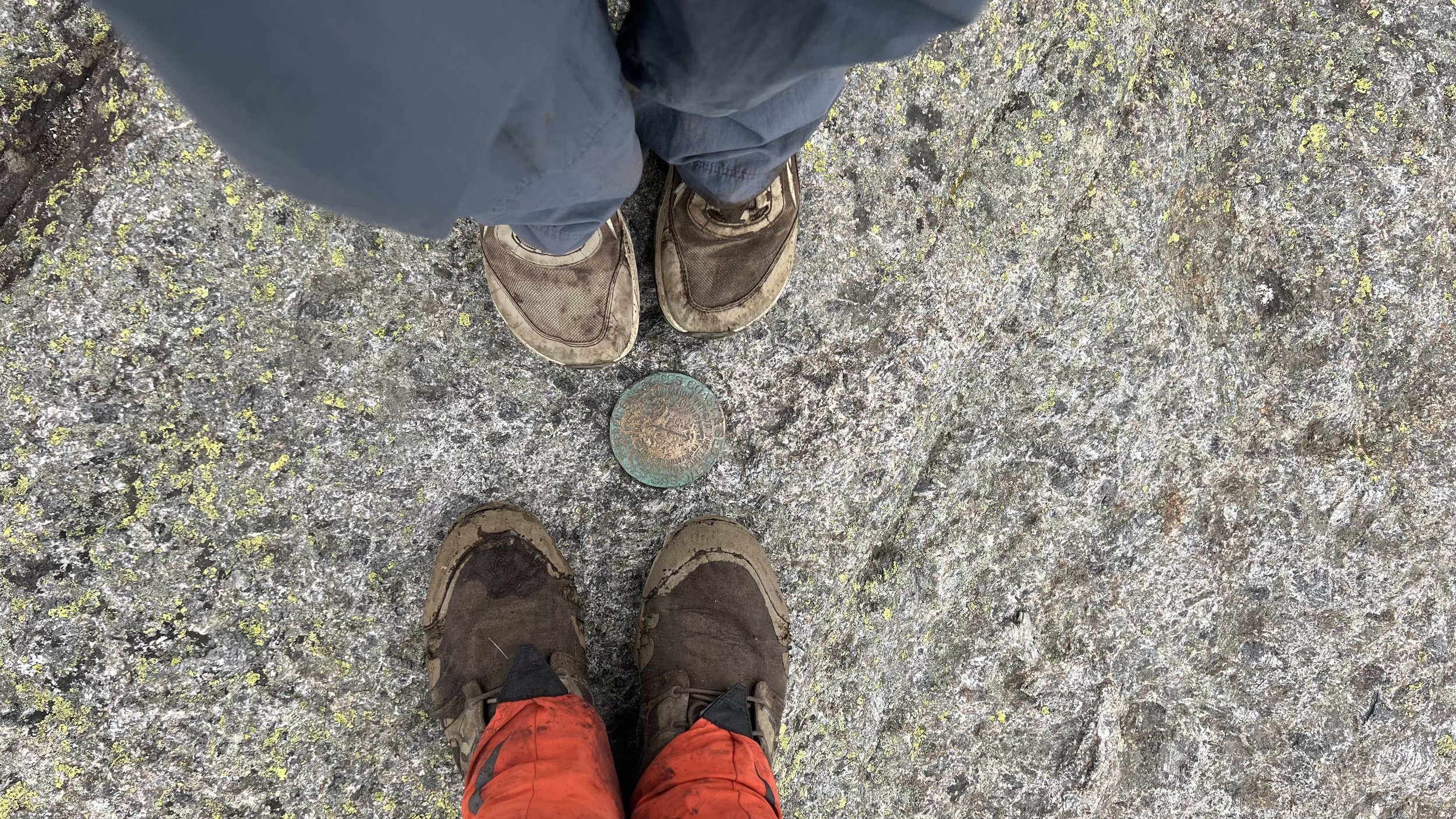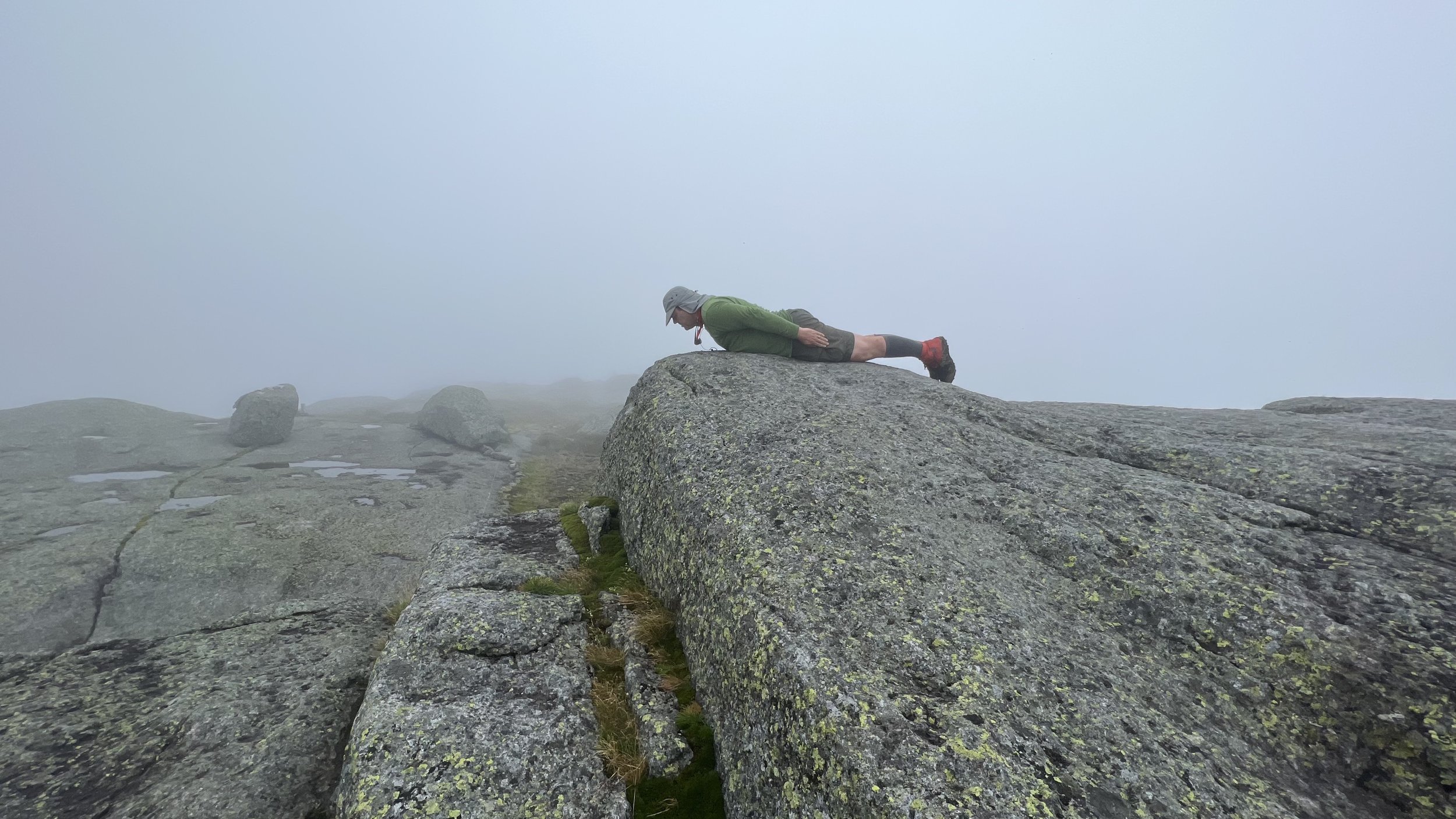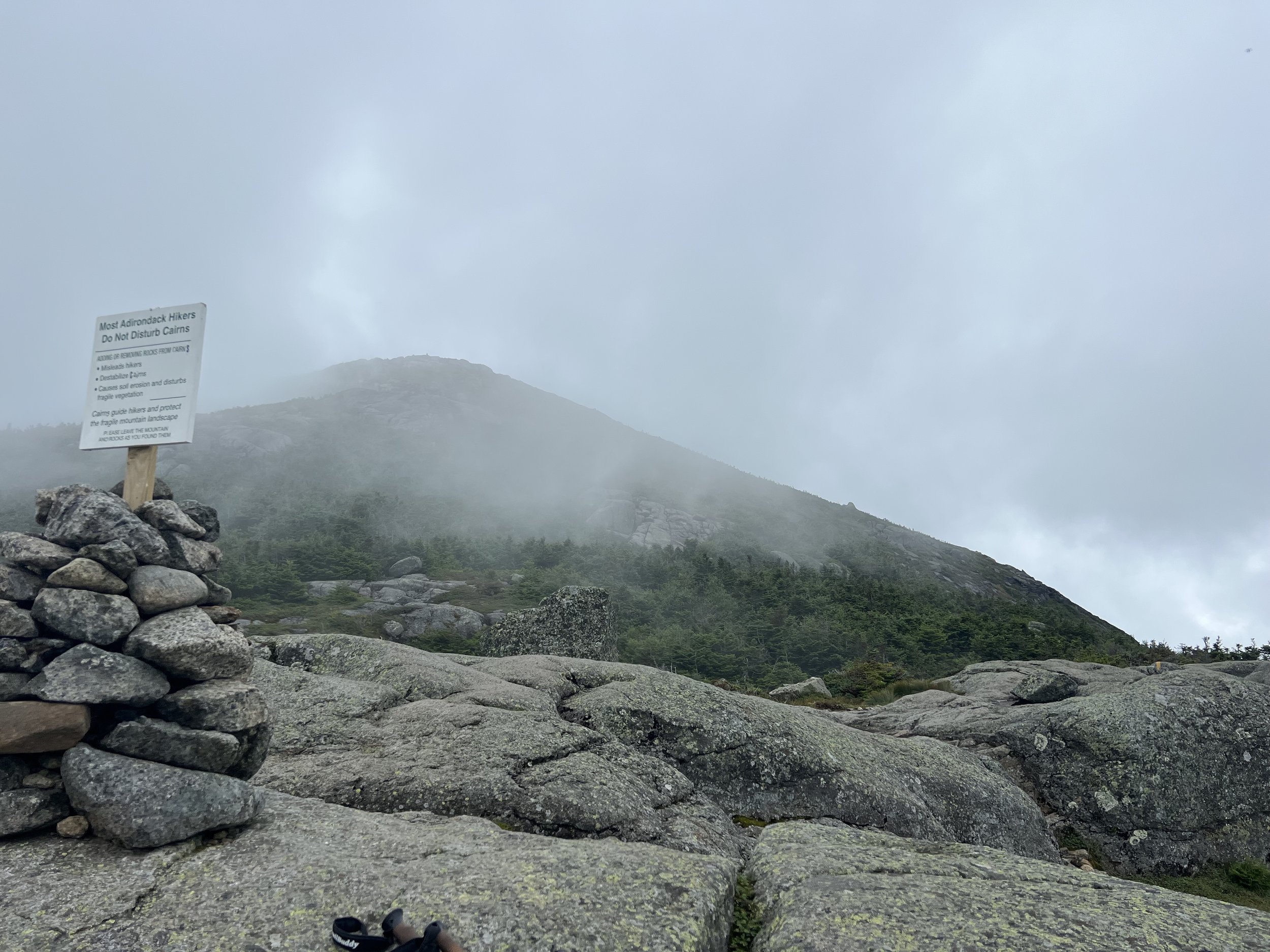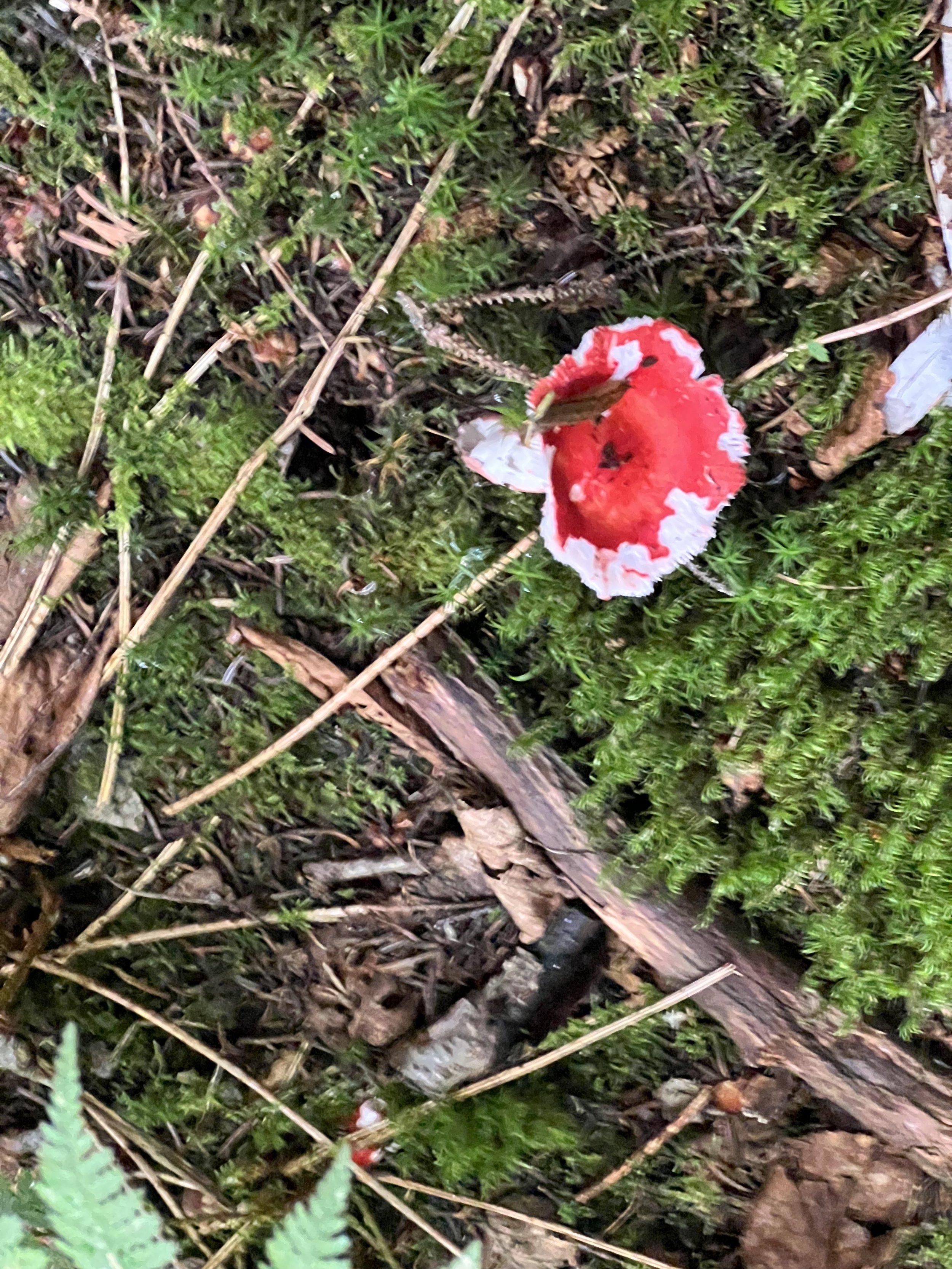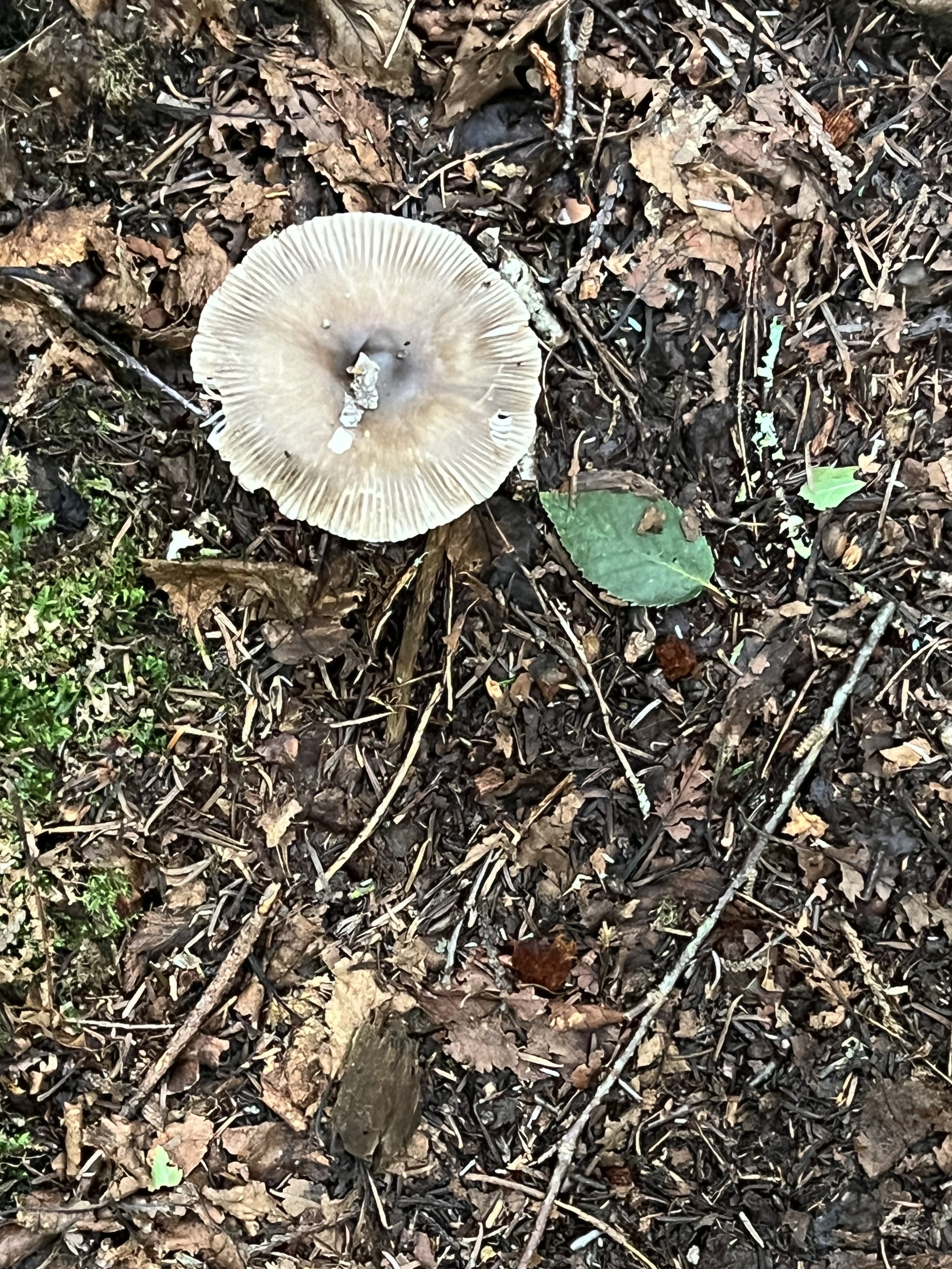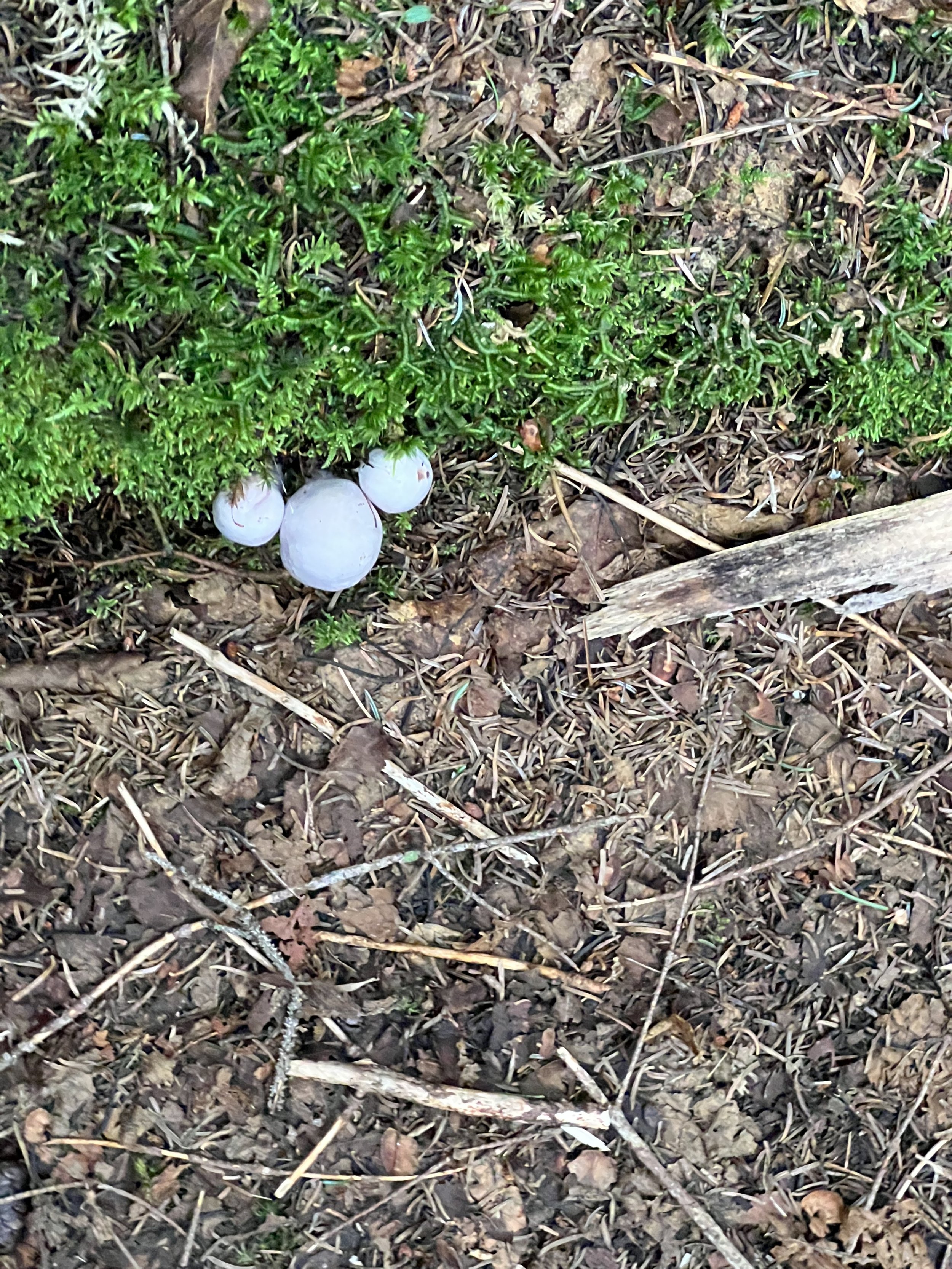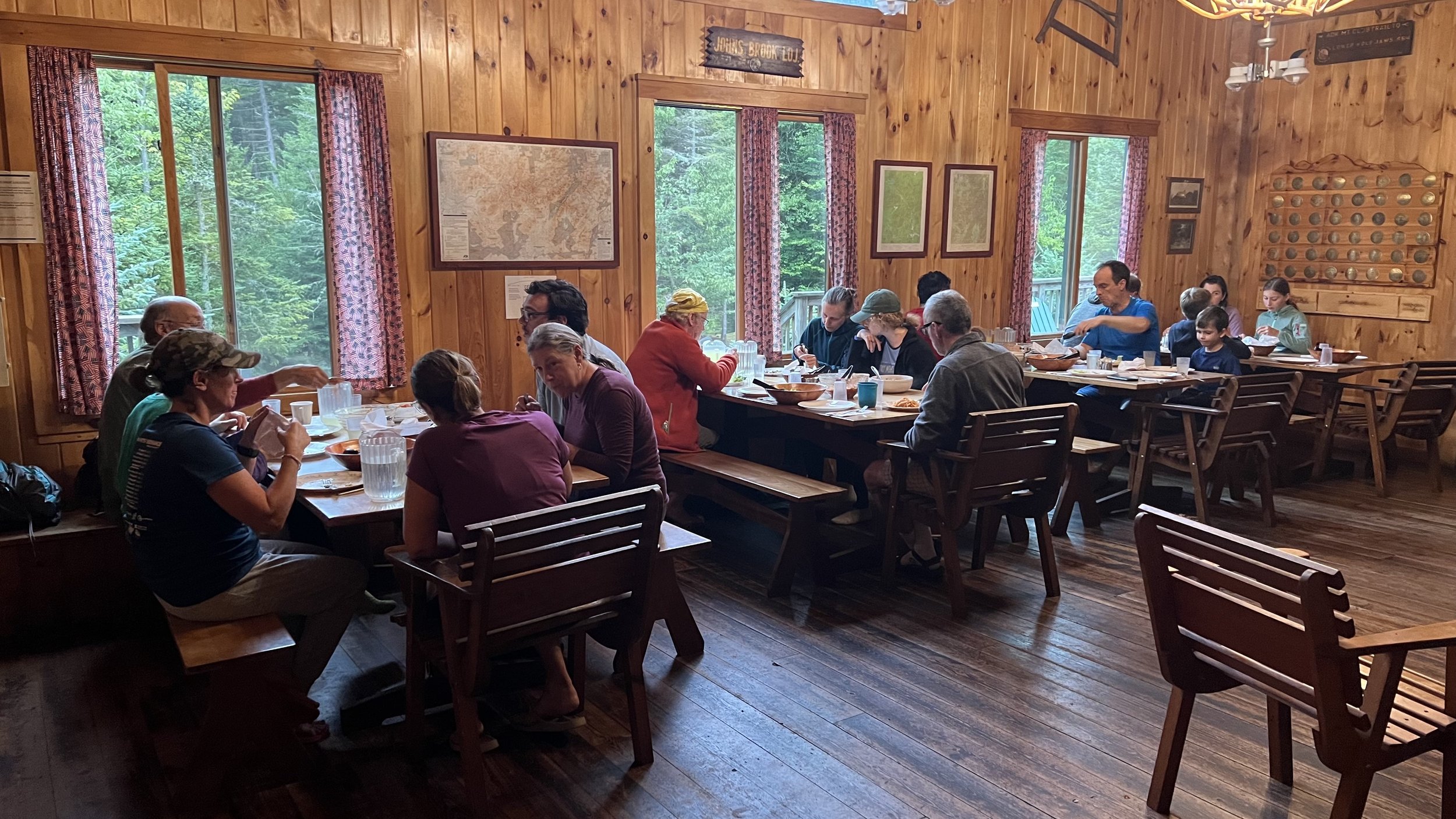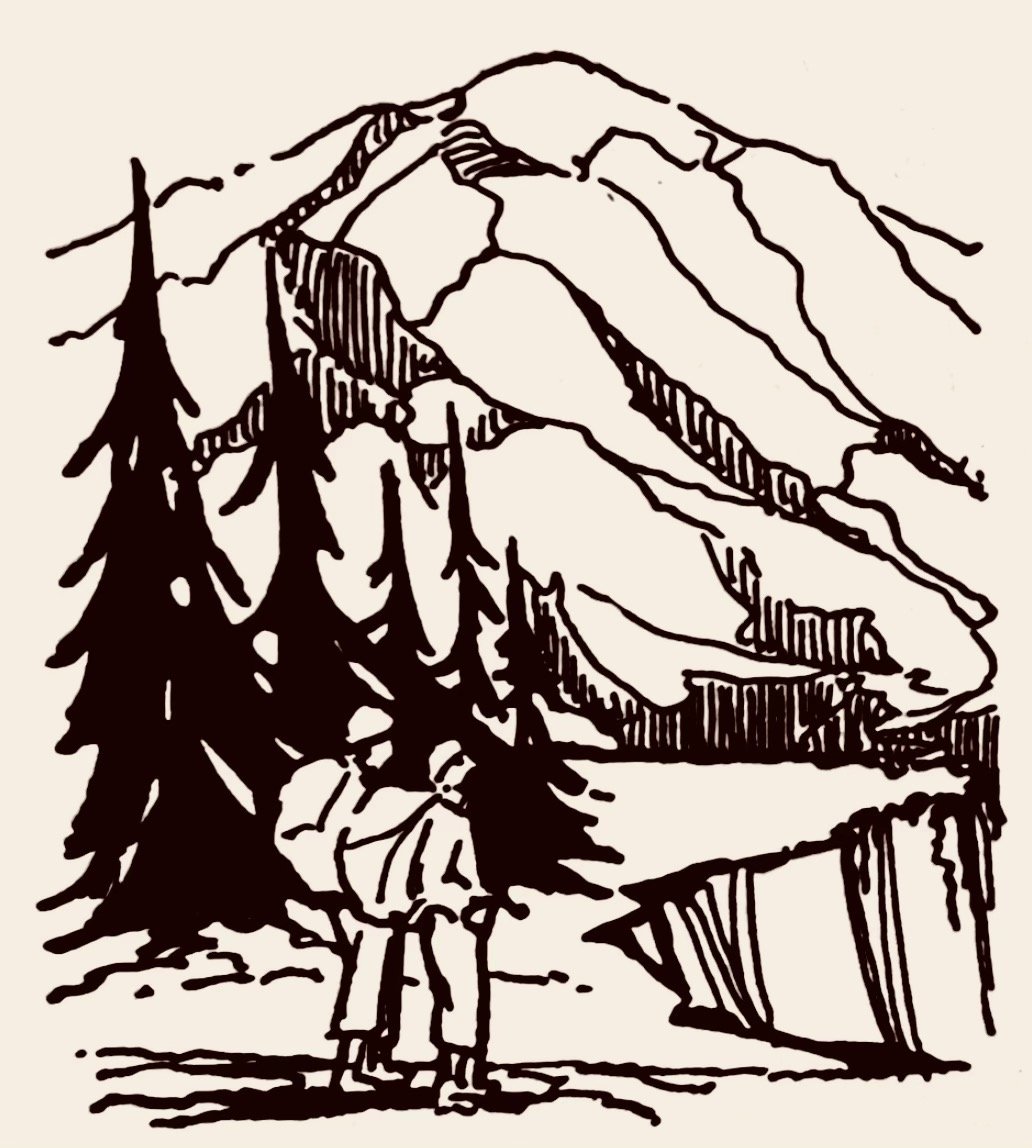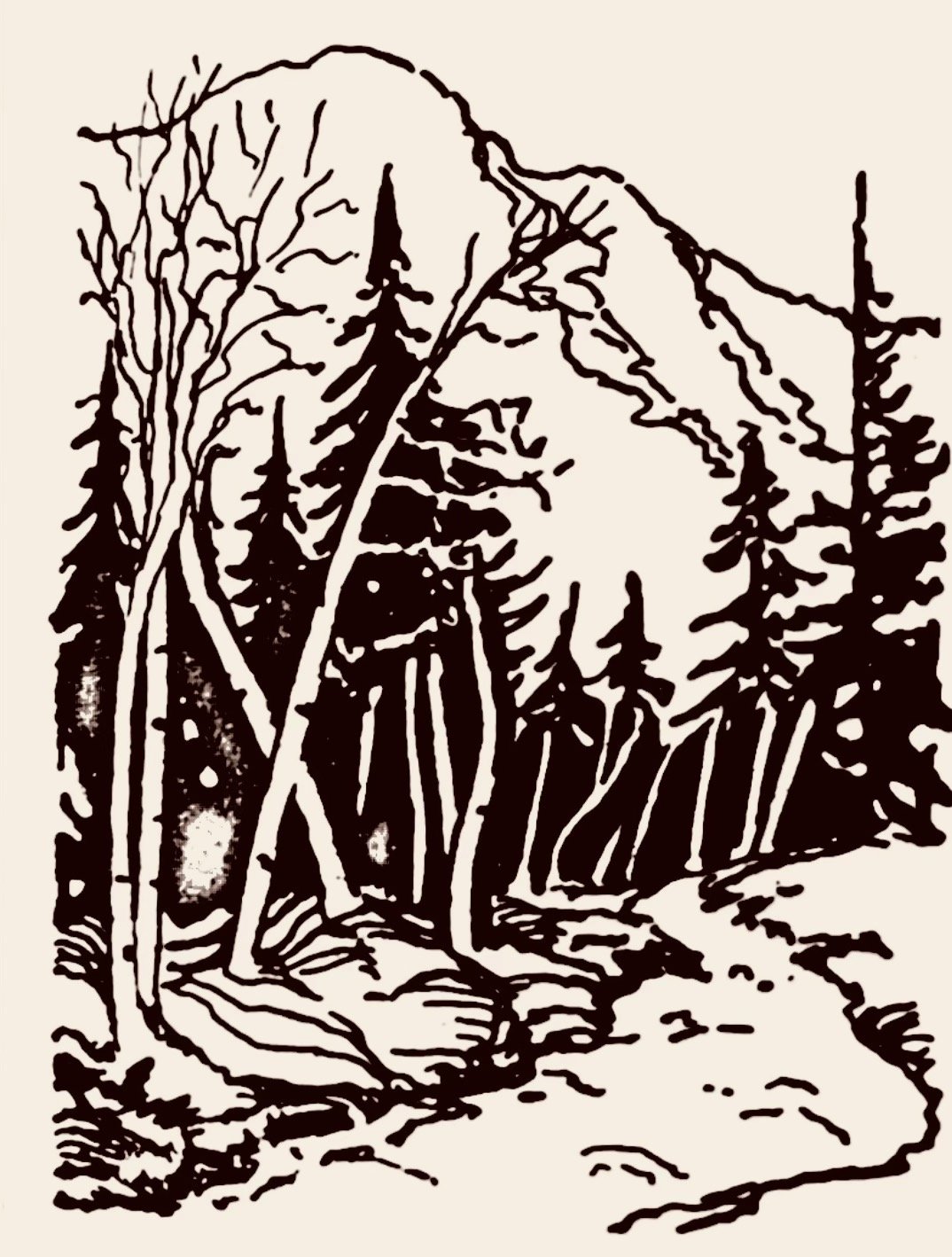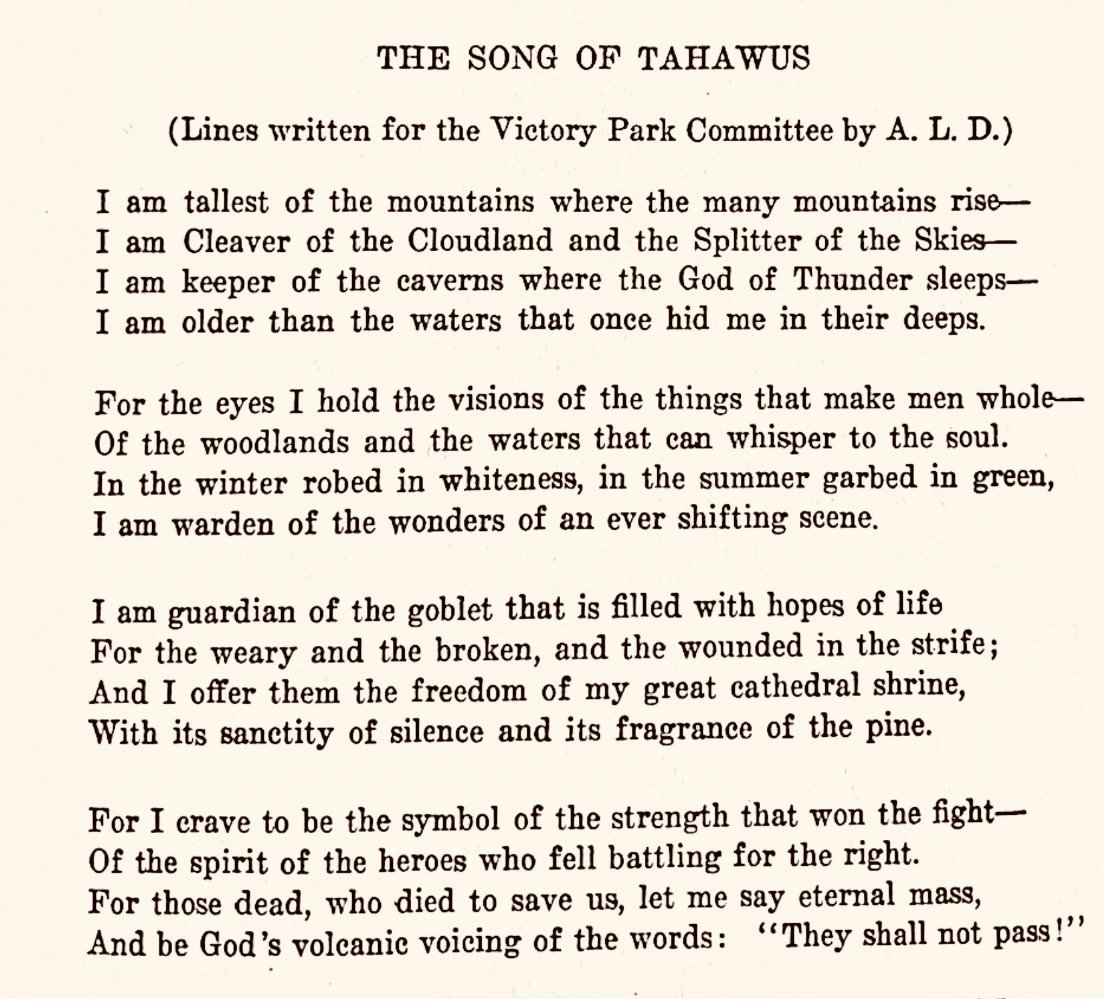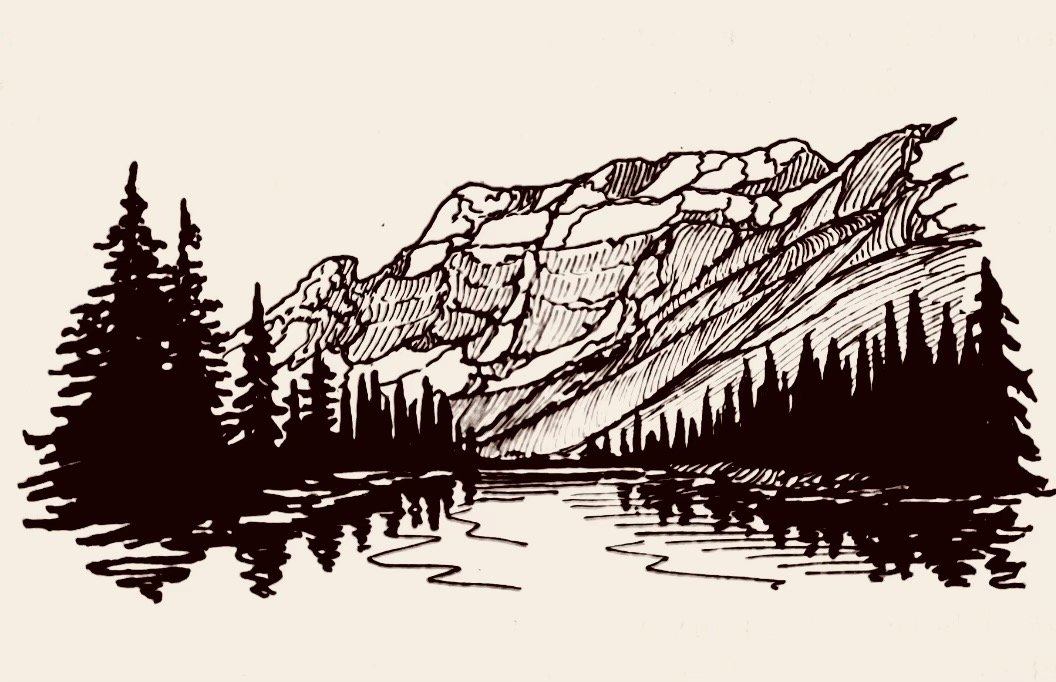The Birth of an Idea
In 2009 we visited Arkansas. We were hiking in Petit Jean State Park. I saw on the map, Mt Magazine. We drove over to see it. We parked the car and took a short stroll through the trees and arrived at a huge sign announcing that we had arrived at the highest point in Arkansas.
A seed was planted in my mind. I began to think about highpoints. We had already made it to the top of Kilimanjaro and I was pondering other summits. I had promised Cindy before we got married that I would not climb Everest, but we had no such agreement about Denali. It was “The Summit” of North America, but it was also the highpoint of Alaska. Between Arkansas and Alaska, the decision to climb all the highpoints of the United States took full shape. I found the highpoint organization, bought some books, and began to make plans.
In 2011, I began the project in earnest. It so happened that a fad was sweeping across the world at the time - planking. Also called "extreme lying down," it involves lying face down on the ground a bit like a plank of wood. It's a bit like the yoga pose but without any of the effort. On a whim, I decided to be the first person to plank all the 50 highpoints. I’ve been pursuing that eccentric goal for more than a decade.
In July, we attempted our 43 highpoint, King’s Peak, Utah. We got within a 1/4 of mile to the summit, but safety concerns caused us to turn around and head back to camp. (That is another story). While on that trip, Cindy and I had been discussing our plans for Highpointing. We already had our trip planned for Mt Marcy in August. We mutually decided that it would be our last Highpoint trip. It was a sad realization, but we both knew that we had started about a decade too late to make it the remaining 6 highpoints. They are all very difficult, require some technical skill or lots of money.
Failure on Mt Marcy
This was our third attempt at Mt. Marcy and seemed like a fitting end to our quest. It would complete all of the highpoints East of the Mississippi. Our first attempt was aborted as we were heading to the trailhead when Cindy’s father was placed on life support. We started a harrowing adventure to get home that took us to New Jersey, repacking in the parking lot and barely making a flight home. We got to Tyler and Bob pulled through his brush with death and lived a number of years.
Our second attempt found us high on the mountain on August 21, 2019 (Lance’s birthday). Cindy, Logan, and I were about a mile and 1/2 from the top (having traveled about 7 miles at that point) when a rainstorm rolled into the mountains. We put on our rain gear, but it was insufficient. It was torrential rain. We kept hiking, once a person is soaked they cannot get any wetter. Then the lightning started. We stopped, took shelter, and waited. We were used to the Colorado storms that blow in and then out quickly. After more than an hour, we thought the storm was relenting. We stepped back on the trail and headed up when a lighting bolt erupted the sky above us and the thunder followed without any interruption. We turned and headed back down the trail.
“Cheney says that Hoffman was the most disappointed and dejected man he had ever seen, when he realized it would be impossible for him to reach the summit of Marcy”
We arrived back at the camping lodge where we had spent the previous night. We had bunks reserved for the night, but everything we had to wear was drenched. The thought of spending the night and then putting on the wet rags to hike the three miles back to our car was too depressing. Also, we wanted to call Lance on his birthday and so we gathered up our things and slogged back to the trailhead. It was three more miles of mud and sloppy mess. We had to hurry because the only way from the trailhead to our car was the hikers’ shuttle or an additional four-mile hike. By the time we got to the bottom, Cindy’s boot sole had delaminated and was flapping. The insides of our packs had degenerated over time and the waterproofing became like flecks of glue on everything inside the packs.
We made the shuttle, got to our car, and then drove to Lake Placid (about 15 miles). We looked like our dogs when I am trying to give them a bath. We were cold, wet, and defeated. We found a hotel, got showers, and then went to the laundromat. We tossed Cindy’s boots (that was traumatic as they had been to the top of Kilimanjaro). We left the area and headed home. It was not a good feeling.
Third Time is a Charm?
The plan was to preach on August 13, then head to New York. I had packed my bags early, one of my anxiety control methods, so we go home from church, made final arrangements at the house, and then head to DFW. We got to the airport in plenty of time, another of my anxiety control methods. We had lunch in the terminal and then got the alert our plane was delayed. We slowed down and finished eating and then were just relaxing when a second message told us that we had to change terminals.
We sprung into action and headed to the trains along with the other 200 people on our plane. The train dumped us out and the first hike of our trip began. We were at the last gate as far from the train station as possible. We arrived and boarding began soon after. The adventure had begun.
We arrived at LaGuardia (in the Queens section of NYC) and then headed to baggage claim. it took nearly an hour to get all our bags. We then shuttled to the rental car place and had another hour wait until they brought us the wrong car, which we then had to wait for another 20 minutes to get that fixed. So, we left NYC two hours later than we had planned for our two hour drive north. When we dropped into bed in a nondescript roadside motel it was after 2 AM.
We still had a long drive north, so it was a short night and then on the road. It is amazing how quickly the density of New York City turns into the beautiful open farmlands and woodlands of upper New York. As we approached Schroon Lake it was time to grab some lunch at a little shop - prepared artisan sandwiches. About 45 minutes later we arrived at the Garden Trailhead. The sign at the entrance said that the parking lot was full. If it was true it would mean adding 4 miles to the trip and parking backing in town. We crept into the lot with trepidation, but luckily a spot was open and we gratefully slid the car to a stop under a towering pine tree.
To the Johns Brook Lodge
We gathered our gear, checking it carefully and at about 2:45 PM we started the nearly 4-mile hike to the Johns Brook Lodge. Owned by the Adirondack Mountain Club, it is a backcountry lodge located in the heart of the Adirondack High Peaks outside of Keene Valley, NY. It can house 28 people in bunk beds and has a staff in the summer that cooks two meals and packs lunches for hikers. It opened in 1925.
The hike begins a slow ascent into an old-growth forest. We are quickly plunged into a twilight light from the cloud cover and the thick leaves. While the parking lot was full, we were alone on the trail. We were hiking with urgency. Dinner at the lodge is served at 6:30. We average hiking about 1 mph. We wish this could be a faster number, but I stop and take pictures, we look at trees and leaves, and we take breaks to breathe and drink. Sometimes we go faster, but on average it's 1 mph. That meant that we would be late for dinner, so we tried to cut out everything but straight hiking.
The trail was wet, slippery, and muddy. It was clear that they had received an incredible amount of rain. We could not initially see the brook of the trail’s name, but we could hear it. We frequently had to divert from the trial which was more like a stream. We crossed a dozen log bridges before descending a bit to the edge of the river. A long exposed rocky area filled us with hope and sound. We knew from previous experience that we were near the Lodge. At 5:30 PM we walked into the lodge. We were tired but proud of our speed.
We contacted the staff to find our bunk assignments. He flipped the papers on his clipboard. He asked my name again. He looked again. “I don’t see you here.” It was obvious that I in fact was “there” so I assumed that he meant on the clipboard. I pulled out a photo of my reservation confirmation. He looked at it. “You are at the wrong place.” I still have not sorted out that whole tangle - how did I make a reservation at the wrong hiking lodge when there is only one hiking lodge? (Another story to follow). He pointed out the mistake. His co-worker stepped up and looked at me in such a way that you know they have lots of pity in their hearts.
He looked back at the clipboard. “I’m sorry, we don’t have any room for you.” I thought about crying. How could this place be thrice cursed? Then the co-worker asked, “Is anyone in Peggy?” He turned to another page. “No, y’all could stay there.” He looked back up at me. “Great! Where is that?” “Oh, just across the creek. You can come back over here and do meals. We will take care of you.”
I was so grateful. I thanked them for fixing my mistake. We loaded up and took the 3-minute walk to the cabin. It was amazing. 12 People can stay in the cabin. It has a central propane lighting system, like built-in Coleman Lanterns. We had the whole cabin for the three of us. It was such a relief. I thought, “Maybe this is going to work.”
We cleaned up a bit, which means I wiped the mud off of my legs and then joined the other 20 or so people at long family-style tables. The chili was filled with onions, so they grilled me some tofu (weird, but filling). The chocolate cake dessert was amazing. All the food eaten at the Lodge is brought in by the camping staff. They each make a weekly run, more often if needed, and bring back huge packs of food. They carry the food and then cook the food. We headed back to Camp Peggy O’Brien and then the three of us played a board game I had hiked in for the occasion. We all slept well.
Toward the Summit?
The next morning dawned with an ominous weather forecast. 70% chance of rain. We asked the breakfast staff and they said, “It's going to rain all day.” We discussed it. Our plan involved spending three nights at the Lodge so that if the first day got rained out we would have a second chance. The weather forecast for Wednesday was better -a 50% chance of rain. We discussed hanging out at the Lodge, playing games and reading books, but ultimately decided to make a summit push. We ate French toast and pumpkin bread. We grabbed our sack lunches, stuffed them into our packs and headed out. Most people looked at us kind of sideways. Lots of people were hunkering down at the cabin. Logan decided not to make the summit run. He injured his knee several years ago and it was not feeling up to the climb. He had bought a good book and was sitting on the porch in an Adirondack chair happily engrossed in his book as we walked into the forest.
The trail from the Lodge to the summit is 5.5 miles. During that distance, it climbs to 5,333 feet, a gain of 2970 feet. That is 274 stories or three Empire State Buildings. These are not like trails in the Rocky Mountains or in the Sierras; these trails were built when trail building was not conceived of with the hiker in mind. It was straight to the top. There are no switchbacks. It's boulder scrambling, mud jumping, slick rocks. We pulled ourselves up. We held onto roots. We jumped across bogs. By our calculation, the trip would take 11 hours. We left at 7:30. We should arrive back at camp just in time for dinner.
Hours passed. We saw no one. The trail was in dreadful condition. No amount of effort could keep our feet dry. We splashed and slogged. It seemed like the trees were actively blocking our path. They aggressively grabbed my clothes, my hat, my pack, and the lanyard on the hiking poles. I felt like they were trying to undress me. I tore the elbow of my shirt. Still, we climbed. We could see nothing but trees. Occasionally, we could hear the river, but mostly the forest was silent. After about 4 hours, the climbing turned very steep. It was about then that the voices started. “It's ok. This is too hard. Turn back.” My lungs agreed. My feet agreed. The cuts, bruises, and bumps on my body all agreed. I didn’t answer the voices - that is a bad sign. We kept hiking and minute by minute the argument in my head kept on its relentless gnawing attack.
We consulted the map. We still had a long way to go. We were not making good time. It looked like it was going to take 12 or 13 hours. That was demoralizing. We would get in after dark and miss dinner. The voices got even louder. We drank some water and ate a snack. We kept hiking. Finally, the trees thinned and we could see the mountain above us. That was even worse. There was still so much height we had to gain. We, however, could see that we were making progress. That made a difference. The steps forward were steps upward and they all made a difference.
Then we saw some people coming down. They had either started way earlier than us, or come up a different trail, but they had been to the summit and were now headed down. They gave us renewed energy. We reached a trail junction which was 1/2 mile to the summit. The trail even leveled out and we were not having to climb so hard. It was a trick. We came out of the woods and could see the top of the mountain. It was still a climb, but we could almost see the top. The final section was now exposed rock. The trail was marked with yellow blazes (1-foot-long yellow painted strips). We had to climb carefully, but we were able to make progress.
“Mount Marcy’s great gift to the climber is isolation —a difficult commodity to achieve these days. . . for a man to emerge from the racket of cities into the mile-high quiet of Tahawus’ top is the greatest luxury procurable.”
Finally, at 1:33 PM we reached the summit. Six hours up. If it takes us six hours to get down we will just miss dinner, but it will still be light. On the summit was a trail steward. We overheard them talking to some other hikers and encouraging them to get off the summit and get going. We stayed just a few minutes, took some pictures, and then headed down.
There was still no rain, but the clouds were swirling around us. Some looked ominous. We wanted to get down and get down as fast as possible. At thirty minutes passed the summit we stopped to eat our lunch. The peanut butter and jelly sandwich was fantastic. They had packed a thick and luscious cookie. It was in a bag of excellent trail mix. I chugged some Gatorade and we were back to hiking in ten minutes. It was the only long break we took the whole day. It was the only time we sat down.
The trail we came up was discouraging and there was a different trail that went back down, so we decided to take it. We had tried to come up that trail the year we got rained out. It would feel good to beat that trail. After just a few minutes we came to a deep swampy area. A couple was standing in the middle of it. They had a map laid out on the back of their pack. They were lost. We stopped. We showed them the trail app on my phone, we helped them find themselves on their map. Then we started down the trail. It was so much easier to breathe, but somehow the trail was even more difficult. We kept coming to huge steps down. We used bushes and trees like gnarled ladders, lowering ourselves over boulders. In other places, the trail was steep, wet, and muddy. About an hour into the descent, I suddenly found myself flat on my back. It had happened in an instant. I was taking a step and then I was looking straight up at the tree above me. I took stock of my situation. I moved my feet and my arms. I was OK. I got up and looked at a long skidmark in the mud. It was like ice.
We needed to hurry, but the trail kept slowing us to a crawl. I did not dare look at the map. I was going as fast as possible and knowing how far we were away from camp was not going to help. We just had to keep moving for the next 4 hours. Then it happened again. I was on my back. As I increased my speed, I increase the chances of falling. At 5:30 PM we reached the trail junction. We were 1.3 miles from our destination. It looked like we might make it before dinner was over. The trail levels off a little and we were able to increase our speed. At 6:19 PM we stepped onto the porch of the lodge. Logan was there to greet us.
We took off our boots. We stepped into the building and sat at the dinner table. We had spaghetti and bread. The apple pie dessert was a great ending to the day. Cindy had a great idea. Instead of staying at the lodge the whole next day and then hiking out on Thursday morning, why not hike out the next morning and then head to the place where I had mistakenly made a reservation? We asked the staff. They made a radio call and it was quickly arranged. We played our table game (Wingspan) and then headed to bed. It was hard sleeping in a room with 12 people. Many were adding additional sounds into the room.
Morning Dawns
Finally, the next morning came. It was raining. It was raining hard. People who had started hiking from the trailhead arrived at the lodge soaking wet. None of us wanted to go out into the rain. Logan and Cindy decided to see if they could get a little more rest. I stayed in the main room and read some journals from the 1920s. I also find a 60 year old copy of “The Little Engine That Could.” It seems like it was waiting on that shelf for me.
Finally, the rain tapered off to a drizzle. If we were going to get out we should leave before the next front came rushing towards us.
We packed our bags, put on our wet clothes, bid the staff goodbye, and headed toward our car. At 11:50 we stepped off the porch. At about 1:30 PM, it suddenly got dark. The rain was coming. The rain arrived. We got our rain gear, covered our packs, and then started marching in the heavy downpour. It was miserable. It lasted about 20 minutes. We just kept hiking. At 2 PM we snapped a picture at the trailhead. We had traveled 3.72 miles. We had made good time.
We dropped our packs into the back of the car. I slid into the driver’s seat. We headed down to the Keene Valley. It felt good to say goodbye to the highpoint of New York.
Why Hike?
I was thinking of my internal arguments and answering the question, “Why do you hike?”
Hiking is one of the easiest ways to be close to nature. Literally, it is putting my feet on raw land. I can feel it through the souls of my boots. It is uneven. It is real. It is a way to feel grounded. To be on the trail is to be in a place and not anywhere else. We spend so much of our lives traveling between places, but not actually inhabiting a space. The speed of cars and planes creates a belief that we are actually not anywhere, but in transit. Unfortunately, it means that we live transitory lives. Too often, we are thinking about, “What is next?,” “Who is next?,” instead of asking, “How can I be right here and fully live in this moment?”
The long repetitive and relatively slowness of hiking helps focus the mind on being present. Time slows down. Our eyes have the ability to see more deeply. Instead of the normal blur, we see out of our peripheral vision.
The uneven surface often means that my head is down and I am looking and calculating my very next step. Not two or three steps, just the next 18 inches. Steps are choices. The thousands of calculations necessary to navigate such a treacherous path drive out almost every other thought. It is a way to put my mind at rest and step away from the many weighty things that often hang in my mind.
Hiking helps me focus on my body inhabiting an environment. As I walked, I created a list of what I was sensing.
What was I hearing?
“Both the Algonquins and the Iroquois claimed the region as a hunting ground, but neither chose to settle there. For them it was Couchsachraga, the Dismal Wilderness.””
First, what was I hearing in the forest? One would expect to hear lots in the woods, but these woods were sanctuary quiet. During the three days of hiking, I can only remember hearing three distinctive birds, and those only for a few minutes in total. The woods were hushed.
I strained my ears to listen. A twig snapped, but we did not cause it. I spun my head, but could not find its source. Later, a large leaf fell from the sky and made the tiniest sound as it joined its cousins on the ground. Occasionally, the wind blew and the leaves rustled as if they were shedding their sleep away.
I listened to my sounds. I was one of the noisiest things in the forest. As I walked, my pack strained. The straps pulled taut groaned and popped on almost every step. The fabric of the pack bunched and crinkled. My breathing hissed as I exhaled or whistled as I inhaled. I hike with poles. I had removed their plastic tips revealing metal spikes. Sometimes they would slip into the mud almost silently. Frequently, they connected with rocks and made clacking sounds.
Then there was my boots. The ground was filled with water. Sometimes, when I pressed my foot down the compression created a squelching sound like worms crying out. When my feet stepped on patches of ground covered with moss the sound was like wrapping a baby in a blanket. Piles of leaves produce the sound of a librarian hushing a group of fourth graders.
The forest was filled with the sound of water. This hike is always near water, even when it cannot be seen. The water burbles in small rivulets. It drips from leaves and rocks into tiny pools. The hushed whisper turns into a chaotic tumbling conversation as we get nearer to the water. As it jumps and tumbles across the exposed rocks the sound changes from high to low tones. Approaching a waterfall, the expansive chamber under the fall creates a resonating cavity and the river speaks with ancient wisdom.
What was I seeing?
The most overwhelming visual stimulus is green. How can there be so many greens? The range is breathtaking. From the dark moss green near the ground to the luminous emerald green at the top of the forest canopy. Trees standing near each other, but as distinctive as if they were wearing uniforms: lime green, pea green, sea green, olive green. It is hard to see anything else but green. Slowly, my eyes begin to recognize tiny flecks of other colors.
Between the leaves, I catch glimpses of cotton white clouds, shafts of amber light, and rarely a daub of sky blue. I put my foot down and saw an apple-red mushroom. A yellow fungus clings to the trunk of a tree. I’m startled and stop to take a picture of a vibrant purple spongy mass. The path is carpeted by leaves. It is like sunlight has been spilled out on the ground. Other leaves have begun the wardrobe change of the autumn, showing hues of orange and red, Birch trees line the side of the trail. When a shaft of light reaches through the canopy of leaves and hits one, the reflection is like seeing a newly painted picket fence. The bark is bright white.
The feeling of the forest.
The grove of trees is resplendent with texture. I brush my hands against soft green leaves. My forearm pushes against twigs and branches which strain and snap while poking into my skin. Lichens and mosses form aging sagging skin enveloping the rocks. My feet feel the sharp edges of the stones embedded in the ground. We pass through acres of ferns: Oak ferns , Royal ferns, Maidenhair ferns, Bracken ferns, Sensitive ferns, Hay-Scented ferns, Interrupted ferns, New York ferns. They are all like platter-sized hands brushing against our shins.
At some moments we have to grab the rocks. They look smooth, but the tips of our fingers feel the rasping crystalline edges of the stone. I pull myself up using a pine root. it is supple in my hands and leaves behind a sticky residue.
I am frequently blazing the trail, which means I am covered with all the spider webs that have been spun since the last hiker came through that trail. I can think of it and my face reflexively twitches in response to the sticky tangles. It feels like I can never really get them off my face.
The forest smells.
I'm not good with the language of smells. Wade has helped give me some new vocabulary as he has been learning the coffee trade.
There are the sweet notes of flowers trying to attract pollinators. We smell wafts that remind me of herbs, but none that I can name. There are the crushed notes of cut grass. The heavy rotting aroma of mushrooms and fungus lingers everywhere in the air. The fresh resin of a pine excites my sinuses and I turn my head to see a blob of yellow goop clinging to a branch. There are pungent waves of rotting wood. Occasionally there is the smell of smoke from some long-forgotten fire. It’s a feast for the nose.
A tasty place
I have no idea how the forest tastes. I avoid gathering mushrooms. The leaves don’t look tasty. I have eaten my fair share of bugs, but they rarely have any distinctive flavor and I'm trying to spit them out. I do keep a roll of Butterscotch LifeSavers in my pocket. Hiking tastes like butterscotch to me. It is the right flavor. It fills me with warmth, sweetness, and nostalgia. Butterscotch is the flavor of my childhood.
A place to be
Step by step I become myself in the forest as I locate myself fully in its embrace. It's why I hike.
Why not quit?
This one is harder.
I am a goal-driven focused person and these self-imposed “finish lines” give me a way to measure a task. I can understand a summit. It feels less like a gerbil wheel running in place. I like knowing where the hike is headed. It’s not necessary, but it makes it more pleasurable. When the hiking gets hard, resisting the urge to quit is in part about pride. I don’t want to be a quitter. It is also about reward. I love the feeling of conquering my body. I love the flood of pleasure upon arriving at a summit, especially if it has been hard.
Many of the highpoints are reached with a few steps out of the car. I remember few of those with much emotional energy. The ones I had to work for are engraved upon my heart. It's why the New York highpoint failures continued to rest heavily upon me. Quitting because I was tired would have become an albatross around my neck. I was unwilling to wear that carcass.
The pain of finishing is more pleasurable than avoiding pain by quitting.
